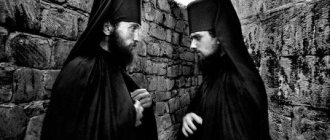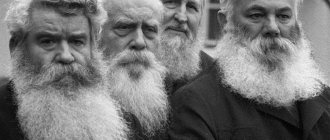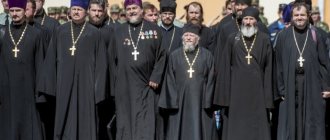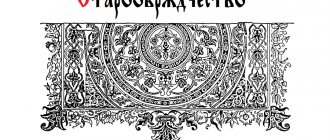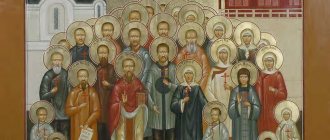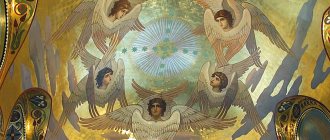Athonite monks, as well as the monks of the Holy Mountain, are ministers of the most ancient monasteries in Greece off the coast of the Aegean Sea. They lead a special lifestyle that helps them maintain not only spirituality, but also health.
Step by step: how to switch to a healthy lifestyle
Life on Mount Athos follows a strict schedule. The day starts at midnight and wakes up at 00:00. The day is divided into three parts, of which eight hours are allocated for sleep, eight for work and the remaining eight for rest. True, even this time is regulated. During the day, Athonite monks pray, serve God, eat, read and rest. Also, everyone on the Holy Mountain is working. Usually these are farming and winemaking.
Photo: Getty Images
The lifestyle of the Athonite monks is recognized by scientists as one of the healthiest. Thanks to this, the residents of the Holy Mountain do not face such terrible diseases as cancer, diabetes and cardiovascular diseases.
Sparring for survival: how Shaolin monks train
How it all began
My acquaintance with Holy Mount Athos began with the works of Elder Paisius the Holy Mountain; one might say, he led me there as if by hand. For such trips you definitely need to take a blessing. My spiritual father, Archpriest Alexey, blessed me not the first time and asked: “Aren’t you afraid to go? After this, your life can change dramatically.”
On a ferryboat
But going to Athos has already become my dream. I decided for myself: until there is a blessing, I will not go. Well, not this year, but next year, so that’s how it should be. And immediately everything worked out in the most favorable way.
The lot of the Mother of God
The Most Holy Theotokos and the Apostle John the Theologian
Once the Most Holy Theotokos, together with Saint John the Theologian, traveled by sea, heading to Cyprus. The ship was overtaken by a storm and washed ashore. The beauty of Athos struck the Virgin Mary, and She prayerfully turned to her Son to grant Her this place as her inheritance. Since then, the whole world has known that the Holy Mountain is the inheritance and garden of the Most Holy Theotokos and the Virgin Mary.
About why to go to Athos
One can compare Athos to a “spiritual university”, where one must come already prepared, even if it is just an “introductory course”. And a parish church is like a primary and secondary school, where we learn the basics of church life. It is known that they don’t get to Athos the first time - it doesn’t work out for various reasons. Apparently, the inner attitude is important.
Ouranoupolis. View from the ferry
Why go to Athos? For myself, I answered this way: work hard. Firstly, spiritually, there was a lot to pray about and for whom. Of course, submit notes and ask for prayers. Secondly, work hard to improve this amazing place. Perform any obedience. Thirdly, to see the places about which I have read and heard so much, where the Athonite elders labored.
How to get there
The journey from Moscow to the city of Thessaloniki by plane takes 3 hours. Then it’s a 2.5 hour taxi ride to the city of Ouranoupolis (but you can get there cheaper by bus), from where a ferry departs every morning and goes along the entire Athos peninsula with stops near monasteries.
The grave of Father Paisius in Suroti, next to the monastery belfry
In order to catch the morning ferry, I arrived the night before and on the way stopped at the Suroti monastery (about 20 km from Thessaloniki) to pray at the grave of Elder Paisios. We spent the night at the hotel, and in the morning we received the Athos diamonitirion at the pilgrimage office, bought a ferry ticket at the ticket office at the pier, and at half past nine we set sail. The ferry was densely filled with passengers from different parts of the Orthodox world. First, the ferry moored to the pier from which the road to the Serbian monastery of Hilandar began; it was not visible beyond the mountains. Then there were stops at the piers of the monasteries of Konstamonit, Dohiar, Zograf, Xenophon. An hour and a half later and at the sixth stop, we got off at St. Panteleimon's Monastery, and the ferry went further, towards Daphne Bay.
Very briefly about the history and traditions of Athos
Athos (or Agion Oros) is an Orthodox monastic republic that once had 180 monasteries, now 20, most of them Greek, one (and the largest) Russian, one Serbian (Hilandar) and one Bulgarian (Zograph). It is also part of the Halkidiki peninsula in Greece, and a mountain whose height is more than 2000 meters. According to legend, the place for her earthly destiny was chosen by the Most Holy Theotokos herself, who became the Abbess and Patroness of the Holy Mountain.
Mount Athos
The monastic republic is governed by the Holy Kinot, or Protat - a cathedral executive body, which includes representatives (anti-prosops) of twenty monasteries of Athos. The protat is located and regularly sits in Kareya.
The climate, vegetation (with the exception of olive trees) and relief reminded me of the Crimean Peninsula - only without modern tourists, women and children. There are no hotels, restaurants or shops either. Near the Daphne pier and in the administrative center of Athos, the village of Kareya, there are a dozen shops and shops, a couple of coffee shops, a police station, a post office and a bank office.
Church of the Assumption of the Virgin Mary in the center of Kareya
Athonite monasteries live and perform services according to “Byzantine time”: a new day begins at the moment the sun sets behind the horizon. And even in different monasteries, the time often does not coincide, and the difference between Athonite and Greek time is from 3 to 7 hours.
It has its own ancient and interesting traditions. For example, in Greek monasteries, before services, a monk walks through the courtyard or corridor and knocks on a wooden board with a special mallet (beat). In St. Panteleimon's, people are called to the service by the ringing of a bell; only once, on the feast of St. Silouan of Athos, I heard the sound of the Athonite “beat” there, apparently because the service was joint with brethren from other monasteries.
Ossuary
In the center of every Greek temple there is a multi-tiered “chandelier” - khoros - hanging on chains, and two more on the side - chandeliers. There is an ancient tradition of rotating khoros and chandeliers during monastic holidays: using long poles with a movable tip, candles are first lit and then swung from side to side. The rotation of the khoros is usually figuratively correlated with the rotation of cosmic systems (galaxies, etc.) as phenomena of different geometric sizes, but of the same spiritual order.
Cell and the Church of the Holy Cross Fr. David
Another well-known custom is that Athonite monks are buried for 2-3 years, after which the remains are taken out and placed in monastery tombs (ossuaries). I saw the same ossuary in the cell of the Honorable Cross near Fr. David.
Geography and climate of Athos
Athos is a mountainous peninsula jutting into the Greek archipelago. The height of the mountain is 2033 meters. the gods Zeus and Apollo lived in temples here . One day, the ancient giants entered into battle with them. Athos was the name of one of the Titans who threw a large stone at Poseidon. The giant missed, and in place of the stone that fell into the sea, a high mountain was formed, which was given the name of the titan.
The peninsula has 20 capes, and on the rocky shores there are bays where ships from the mainland arrive. Highways lead deep into the peninsula. There are mild, rainy winters and hot summers. Snow falls rarely and does not last long. The source of drinking water is streams flowing from the mountains.
The landscape of Athos is inspired by luxurious greenery: spruce, chestnut, oak forests, dense bushes. On the mountain slopes there are plane trees and citrus fruits, apple and pear trees, cherries and grapes, walnuts and olive trees. Well-trodden paths, not mutilated by concrete, are covered with acorns and chestnuts, cascading down from hundred-year-old giant trees.
You are enchanted by the gentle sea, the peaks of low mountains in a bluish haze, hanging vines and the crosses of monasteries, cells and hermitages towering everywhere you look. The caring presence of a person does not in any way disturb the natural harmony.
About the Russian St. Panteleimon Monastery
This year marks the millennium of Russian monasticism on Mount Athos, first mentioned in sources in 1016. St. Panteleimon's monastery today is a whole monastic city with restored churches, with dormitories and a pilgrimage center, a large farm and a huge refectory. In the main cathedral of the Russian St. Panteleimon Monastery on Mount Athos, consecrated in honor of the holy great martyr and healer Panteleimon, the honest head of this great saint is kept. Also in the churches there are many miraculous icons and parts of the relics of over 300 Greek, Russian, Georgian saints are stored, to which after almost every service one could approach and venerate. From 1979 until August of this year, the abbot of the monastery was Hierarchimandrite Jeremiah (Alekhine), who was born in pre-revolutionary Russia - in 1915. Hierodeacon Evlogy became the new abbot of the monastery. There are now more than 70 monks. In addition to spiritual feats, the maintenance of the entire troublesome monastery economy and the reception of many thousands of pilgrims rest on their shoulders.
St. Panteleimon Monastery
About the daily routine. The day in the monastery is divided into three parts: worship, obedience, rest (for the monks this is only a few hours). According to our time, Matins begins at 2.30 am and goes into the liturgy, which ends at 8.00 am. Then a meal follows and obedience begins. From 16.30 to 17.30 Vespers are served. At 18.00 - the second meal, if it is not a fast day. Following the second meal, they call for Compline, from 19.30 to 21.00, and there are a few hours left for sleep...
About worship. The most important and difficult part of the pilgrimage. Takes a total of at least 8 hours a day. True, according to the Greek tradition, all the churches here have stasidia [1], on which you can always lean your elbows and sometimes sit down. The rules for staying in the monastery state that pilgrims are required to attend all services. Daytime services are easy and joyful, night services, especially at dawn, are given by overcoming oneself. By about the third day you’re already getting into it. Daily services are held either in the lower church, dedicated to St. Panteleimon, or “in the upper”, the Intercession of the Virgin Mary. Change occurs once a week. I especially remember the service on the feast of Silouan of Athos, who is revered by the whole of Athos, and for our monastery it is like a patronal holiday. Two choirs sang in turn, in Church Slavonic and Greek. On this day, candles were lit in choirs and chandeliers, and they were swung...
Olives and Mount Athos
About monastic food. The huge new refectory of St. Panteleimon's Monastery amazes with its bright, frescoed walls and high vaults and can accommodate up to 2,000 people! As is customary in monasteries, everyone enters at the same time, reads a prayer of thanksgiving and begins to eat in complete silence while reading stories from the patericon and finishes at the same time. Monks and pilgrims eat simple Lenten food, but deliciously prepared - porridge, soup, fish on holidays, delicious monastery olives and amazing dense black monastery bread, and also sweet fragrant tea with Athonite herbs, which I have never drunk tastier.
About the benefits of obedience. Obedience for pilgrims is voluntary. Having settled into the monastery, I decided to ask for some business, and it was quickly found. First, we unloaded the ferry, which brought many different products from the mainland. Then they sorted the olives from the monastery garden, which were soaked in brine in large vats. While we were cutting onions and herbs for the kitchen, my comrades also ended up in a more important area - collecting firewood and removing garbage. The fastest and most coordinated work was in the kitchen: after the meal they cleared away the plates, immediately clearing leftover food from them, wiped the tables and swept the floor. During these classes, my soul felt especially light and joyful; I really wanted and was able to pray. Through obedience and hard work, it was possible to get to know and communicate a little with the monks and see the life of the monastery from the inside.
Men's Republic: rules of life for Athonite monks
Change yourself
A monastery is a place where only the necessary minimum of time is devoted to everyday concerns. However, a family man living in the world and forced to solve many mundane problems every day can take an example from the monks. What? Let's go to Mount Athos today, see how its inhabitants live and think about what rules of their lives we could apply ourselves...
Greece. Athos Peninsula Monastery of Agia Pavlos. photosight.ru. Photo: Alexander Osokin
There are not many communities where men gather alone for a long time. Off the top of my head, I can think of three: the army, the prison and the monastery.
The first, of course, is the need to defend against external enemies, the second is the need to isolate those who do not want or could not live according to internal laws, the third option is a voluntary meeting to achieve the Kingdom of Heaven, that is, what is outside of space (in the Greek understanding of this words).
The army lives by the laws of war - everything must be subordinated to efficiency in battle and safety in leisure. In prison, people also came up with certain rules of life for themselves, partly based on the desire for justice, the right of force, partly for self-preservation, taking into account the characteristics of the people who ended up there. In the monastery they live according to the laws of the Gospel. What the men’s groups have in common is the following: discipline, simplicity of life and simplicity of food
.
Many of us have an idea of how the monastery works because we have been on pilgrimages. But how life can be organized on a peninsula where no woman has set foot for a thousand years is interesting...
The first thing that catches your eye is that there are a lot of cats on Athos - they live comfortably here, and they help fight snakes, scorpions and other creeping reptiles. Their massive presence here destroys the myth that even the animals on the island are all male. There are two types of living creatures on Mount Athos, but there are no human women here.
On Athos. Photo: priest Dmitry Berezin
All the lands of the peninsula belong to monasteries, so only monks, novices and laborers and workers live here. Monks are those who have decided to leave worldly attachments and worries in order to completely devote their lives to serving God through obedience, abstinence and non-covetousness.
. These are the three main vows of monasticism. Novices and laborers are those who came to work in the monastery: some in search of monasticism, some for a while, to spend it with benefit for the soul. Workers come to work, for example, on strengthening roads, logging, etc.
There are twenty monasteries on Mount Athos, and they are all very different from each other. In some monasteries, the abbot believes that monks should not engage in labor duties, but should only pray; in others, on the contrary, physical labor is one of the main monastic obediences.
A combination of cordiality and strict rules
Monastic morals are strict, but imbued with deep love for people. For example, people here don’t like wandering pilgrims who walk from monastery to monastery for weeks, or even months, instead of being with their family or truly working and praying in one monastery. But on the other hand, each arriving traveler is led to the archondarik - a special room for guests, where they will certainly be offered a glass of ouzo (anise liqueur), water and Turkish delight. This long-standing tradition helps to quickly restore strength after the journey, because despite the presence of cars, the main means of transportation remains the legs. In the monastery you can stay for one night for free, attend services and participate in the monastic meal along with everyone else. If you want to stay for two or more nights, you need to carry out some kind of obedience or receive a special blessing.
On Athos. Photo: priest Dmitry Berezin
Simplicity
It is necessary to say separately about the meal: on Athos they do not eat meat at all, and fish and seafood are served in most monasteries only on major holidays. The dishes in all monasteries are simple, made of stainless steel. But the refectory premises can compete with the temple in antiquity, paintings and the seriousness of the structure. The entrance to the refectory is usually located opposite the entrance to the temple. At the same time, the meal is simple, but satisfying and healthy. Vegetables and fruits lie washed - if necessary, they will be cut or peeled. When the reading of the lives of the saints ends, the bell rings, a prayer of thanksgiving to God sounds for what He sent on this day, and people disperse to their obediences or deeds.
Interestingly, there are practically no mirrors on Athos. And really, why are they in a place where your appearance, in general, is not important, what matters is what you are like inside. Swimming in the sea is also prohibited here; for this you can even be expelled to the mainland. Visiting pilgrims live according to monastic rules, and monks have no need to bathe.
Prayer
They live in monasteries according to Byzantine time, the day begins to count from sunset, but so that pilgrims do not get confused, they are given Greek time. In the morning, the service begins somewhere at 3:00, sometimes at 4:00 Greek time and lasts until approximately 8:00. After the service there is a meal. The evening service usually begins around 17:00 and ends around 21:00, after which the second meal is dinner. Divine services are performed mainly in Greek, but in Russian Panteleimonovo, Bulgarian Zograf and Serbian Hilandar they serve in Slavic, and in Romanian monasteries - in Romanian. The main difference between the Athonite monastery service and the usual Russian one is that twilight reigns in the temple - only a few lamps are lit, and electricity is practically not used here.
Stasidia are placed along the walls - these are special wooden chairs in which you can stand, holding the armrests, you can sit down slightly, or you can sit down completely if the seat is folded out. The services are long, daily, and of course, not everyone is healthy enough to stand them. Moreover, at certain moments of the service you are required to sit according to the regulations.
It is quite difficult for a Russian pilgrim to closely follow the Greek service, but here the rosary and the Jesus prayer “Lord Jesus Christ, Son of God, have mercy on me a sinner” come to the rescue. After all, prayer is not only the words with which we turn to God, it is also a state of the soul open to Him.
Patience and work
But the morning service ends, and after the meal it’s time to move on. Motor roads (mountain dirt roads with all their features) appeared on Athos relatively recently; before that, the monasteries had only descents to the sea. Nowadays, too, everything gets here by sea, but most of the monasteries are already connected by roads. However, there are monasteries and monasteries that can only be reached by sea or on foot.
When you look from below at the almost vertical cliffs, where temples, cells and walls are built above, you can’t help but admire the patience and hard work of the monks - all materials (except perhaps stone) and tools had to be lifted on oneself or with the help of mules.
On Athos. Photo: priest Dmitry Berezin
“We left the world on Athos, and now the world is coming to us”
Athos showed many examples of monastic holiness, became the cradle of Russian monasticism - it was from here that Anthony of Pechersk came to the Kyiv lands. There are also our contemporaries: Saints Silouan of Athos, Porfiry Kavsokalivit, Paisius the Svyatogorets. There are also monks who are not glorified, but who have shown an example of spiritual heights.
Now they are especially trying to get to a conversation with Archimandrite Ephraim, Pope Janis (hieromonk John) and Archimandrite Gabriel. “We came to Athos to get away from the world. And now the world is coming to us,” Pope Janis laments, sternly reprimanding the Greeks who came to him for a spiritual conversation. By the way, all Athonite elders and abbots of monasteries are very strict about issues of family life: cohabitation, divorce, second marriage, a small number of children are not blessed and do not find support from them except in truly objective and hopeless situations.
On Athos. Photo: priest Dmitry Berezin
More than once they tried to violate or cancel the ban on women visiting Mount Athos, but it continues to exist, because otherwise the harsh sanctity of these places will be violated - the world will burst in here and fill everything with vanity. There must be a place on earth where one could feel the breath of eternity. The monastery is not a path for everyone, but many pilgrims return from Athos every year, sharing with others a peaceful state of mind, until the whirlwind of worries stirs it up again.
Each of us needs to learn to make time to break out of the hustle and bustle and truly devote time to eternity, thinking about the truly important issues of existence. And based on these criteria, fill your everyday life.
About other monasteries and cells, about walking routes and why you still need a staff
The territory of Athos itself is conducive to walking, and many monasteries can be reached along beautiful paths, along bridges and crossings over mountain rivers and streams, past ancient cells and chapels, olive gardens and vineyards... In this regard, it is best to travel around Athos in autumn or spring, when it's not hot. A staff will be useful along the way. Staves are very popular on Mount Athos; they are made by the monks themselves. They make it very easy to go up and down mountainous terrain; their sound on the road drives away snakes.
Bridge to Panaguda
Each Mount Athos monastery has its own uniqueness, beauty, shrines and historical and architectural features. For example, services in a language understandable to Russians are held in the Serbian monastery of Hilandar. It is also famous for the fact that the monks there somehow especially pray strongly for the healing of infertility and give pilgrims who come for help in these matters a grapevine as a blessing.
The seven-story Simonopetrov Monastery is perhaps the most architecturally amazing building on Athos, a miracle of monastic architecture, standing on a high cliff. And they say that the best monastery choir is there.
Iveron Monastery
On a hill by the sea there is the beautiful Iveron Monastery (Iveron), once Georgian, and now Greek, the largest shrine of which is the miraculous icon of the Most Holy Mother of God - Portaitissa Iveron. According to Tradition, the icon miraculously “came” to the monastery by sea during the period of iconoclasm, as described in the frescoes at the entrance to the monastery.
Dohiar Monastery
Not far from Iveron, an hour’s journey higher into the mountains, stands the ancient and very cozy monastery of Philotheus, in which the miraculous icon of the Mother of God “Sweet Kiss” (Greek “Glykofilousa”), according to legend, painted by the Evangelist Luke himself, is kept and amazes with its depth.
Kutlumush Monastery
Near the village of Kareya there is the Kutlumush Monastery, the wooden iconostasis in the cathedral of which is considered one of the most beautiful on Mount Athos. It includes the cell of Panaguda, where Saint Paisius the Svyatogorets labored for many years. Nowadays the hospitable Greek monk Arseny lives in it, who gladly welcomes pilgrims, according to the tradition of Father Paisius, treats him to Turkish delight and spring water and shows him the temple of the cell where the holy ascetic prayed. And next door, in the cell of St. Christodoulus, Father Gabriel, one of the most famous modern Athonite elders, lives and instructs pilgrims. At the entrance to its kaliva, an amazing tree in the shape of a cross grows.
About temptations and blessings, joy and sorrow
In general, on Athos one often hears just such a conversation and consideration of various issues through these two concepts - temptation and blessing. Here I learned a lot from communication with Archimandrite David, from the cell of the Honorable Cross.
Father David
One personal example: on the advice of experienced people, when leaving the cell of the hospitable Father David, I asked him to call the minibus driver to reserve a seat, which he did in front of me. So what: I arrive early, while it’s still dark, and I watch an amazing sunrise. I find a fig tree by the road with several fruits on it, and I eat them with pleasure. I photograph the rising sun over the sea and wait for the bus. Exactly at 7:15 he arrives and unexpectedly drives by, the driver just threw up his hands, saying, there are no seats, signomi! - I'm sorry. I felt sudden anger - after all, I had done everything in advance! I planned it and booked the place. And the backpack is heavy, it will be difficult to walk far with it, 4-5 hours. I think I’ll call Father David, wake him up and ask him to take me by car. Let him work hard, since this happened. And I was about to pick up the phone, but I stopped myself. Why wake a person up and bother him? I'll go on foot, maybe someone will pick it up. He humbled himself, calmed down, and began the Mother of God rule. I walked about five hundred meters - and suddenly another bus arrived, half empty, and it was the one that took me to Karya.
Dawn on Athos
On the other hand, any event can be perceived as a temptation or a blessing. Talking with Father David, I asked him how he, being a monk, manages to do so many things: to build and clean all the premises (which is 800 square meters), and to receive pilgrims, and to cook, and to manage the household (he has a vegetable garden, chickens). And at the same time - pray. He replied that he always prays, no matter what he does. And he added that they always replace each other: if you overcome temptation, wait for blessing. And it is important to understand this. And that much depends on our inner attitude: often where temptation is seen (for example, in the household, distracting from prayer), I see blessing. I was also surprised that Father David does everything with joy, and I was tempted to ask: what about sadness and grief about the troubles of the world? When asked about this, he answered this way: yes, I am sad about my sins and the sins of the whole world, but the joy from God’s presence in me is greater, and it always overcomes sadness.
So what is Athos?
A place of subtle perception and feeling of God and his will, help and “gifts” from God and the Mother of God. If you do not carry out your own will, but seek the will of God and want to fulfill it, then the Lord controls everything in the way that is best for you, and all problems seem to be solved by themselves. The place of intense spiritual work is prayer.
Elder Gabriel's Kaliva
A place for obedience - there is no other way to enter into communication with the monks and the monastery. Celebration location: every night service is an event. And every service is exceptional. Travel destination - many interesting walking routes, beautiful paths, buildings. The meeting place is with enthusiastic pilgrims, with monks, with elders (visibly and invisibly). With the saints, the Mother of God and God - on the Holy Mountain it seems closer to them.
[1] Stasidiya is a wooden chair with a folding seat, a high back and armrests.
Mount Athos and the European Union
— The Greek press is again writing that the European Union wants to abolish avaton, an ancient rule that prohibits women’s access to Mount Athos. How possible is it to remove an avatar today, in your opinion?
— There was no news reason for the news about the cancellation of Avaton. Speaking about this once again, the press did not provide any specific information - neither statements by officials, nor any decisions of the European Parliament, PACE or other organizations. The conversation was in the spirit that after the adoption of the law on the legalization of same-sex unions, further gradual de-Christianization will be carried out in Greece - and, perhaps, in the future, one of its stages will be the abolition of avaton.
The latest story related to an attempt to abolish this ancient rule dates back to the beginning of the 2000s. Then, in the European Parliament, 274 deputies spoke in favor of the abolition, 269 were against it, and another 14 people abstained. And about a year ago there were rumors that the World Council of Churches allegedly voted to remove the avaton, but this turned out to be unreliable information.
There are currently no facts indicating that the abolition of Avaton is being prepared in the near future. Moreover, this is now impossible, since it will lead to a very large resonance and protests within Greece. The status of Mount Athos is protected by Article 105 of the Greek Constitution and a number of agreements between Greece and the EU. Legally, the land of Athos belongs to twenty monasteries - the monks have the right to limit the right of entry to the Holy Mountain to those for whom they deem it necessary. The question of removing your avatar can be compared to the following situation: you have a 3-room apartment, and then the city hall comes up with a decree that you need to move three more people into your apartment.
— And if we talk about the long term, what is it?
Appearance of the Most Holy Theotokos to Venerable Athanasius
— Of course, the question of removing the avaton will sooner or later be brought up for discussion. But before that, many other things in Greece need to be dismantled - for example, icons hang in hospitals and courthouses in Greece. Gradually, they are already beginning to be removed: just the other day, at the Faculty of Theology of the University of Thessaloniki, the icon of Christ was removed from the entrance and taken away from view, to the fourth floor, despite the protests of a number of teachers and students. The process of secularization is underway in Europe, and Mount Athos will certainly be the target of attack. But not now—later.
— A number of Athonite monasteries receive financial assistance from the European Union in restoration matters. How dependent do they become on the EU through this?
— At the moment, there have been no attempts at direct pressure, no attempts to impose anything on the monasteries. But I do not rule out that something similar could happen in the future.
On Mount Athos itself there are different opinions on this matter. For example, the Kostamonit monastery fundamentally refused financial assistance from the EU. They openly declared: we are afraid, we are afraid of the abolition of Avaton, and we do not want to receive a single cent from the EU, so as not to become dependent. Other monasteries did not see this as a threat or considered it to be irrelevant at the moment.
This question is closely related to the question of attitude towards modern technologies on Mount Athos. A technological revolution took place before our eyes - the Internet, transport, and infrastructure appeared. On Athos there are different points of view on how to relate to the progress of technology, how compatible it is with monasticism, and how much it is possible to recreate monasteries - in that majestic form and at that technological level, as often happens now.
At the moment, Kinot artificially limits the development of transport infrastructure, asphalting, and the use of transport. In many monasteries, monks do not use the Internet or mobile phones at all - and, for example, the same disciples of Elder Paisius today are limited to a minimum of resources: they do not even have a pump to pump water: they get it by hand, as has been done in all centuries. The attitude towards technology is cautious. And the same applies to the issue of EU financial assistance.
